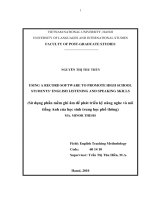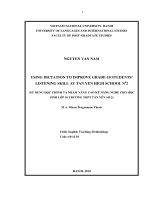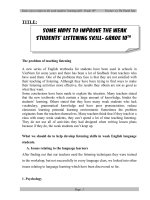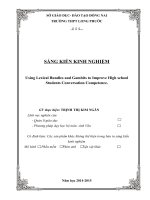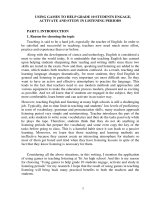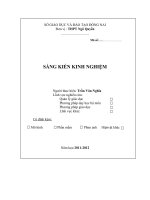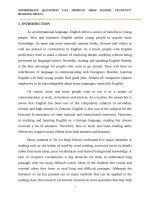skkn using context to improve high school students’ vocabulary
Bạn đang xem bản rút gọn của tài liệu. Xem và tải ngay bản đầy đủ của tài liệu tại đây (724.74 KB, 38 trang )
APPROPRIATE QUESTIONS
READING SKILLS.
CAN
IMPROVE
HIGH
SCHOOL STUDENTS’
1. INTRODUCTION
As an international language, English offers a source of benefits to young
people. First and foremost, English assists young people to acquire more
knowledge. As more and more materials namely books, lectures and videos as
well are printed or constructive in English. As a result, people with English
proficiency tend to stand a chance of exploring deeper anything without being
prevented by language barrier. Secondly, reading and speaking English fluently
is the best advantage for people who want to go abroad. They will have no
interference of language in communicating with foreigners. Besides, learning
English will help young people find good jobs. Almost all companies enquire
employees to be knowledgeable about some languages, especially English.
Of course, more and more people want to use it as a means of
communication at work, in business and tourism. As a teacher, the researcher is
aware that English has been one of the compulsory subjects in secondary
schools and high schools in Vietnam. English is also one of the subjects for the
Entrance Examination of some national and international university. However,
in teaching and learning English as a foreign language, reading has always
received a lot of attention. Therefore, how to teach and learn reading skills
effectively requires many efforts from both teachers and learners.
Many students in Tri An High School confronted five major obstacles in
reading such as: the habits of word-by-word reading, excessive focus on details
rather than main ideas, poor vocabularies and limited background knowledge. A
lack of receptive vocabularies is big obstacles for them to understand long
passages with too many difficult words. Most of the students feel scared and
worried when they have to read long and difficult passages. Although the
literature so far has pointed out so many methods that can be applied in the
reading class, this research exclusively focused on some questions that may help
1
APPROPRIATE QUESTIONS
READING SKILLS.
CAN
IMPROVE
HIGH
SCHOOL STUDENTS’
students understand the passage and choose the suitable answers. This matter
has inspired the research to carry out the research with the hope that through
this study, the researcher will have better teaching approaches so as to improve
students’ reading skills.
2- LITERATURE REVIEW
2. 1- Definition of reading and reading comprehension
Reading is an important skill to help people learn from human knowledge
and experience. Through reading, knowledge has greatly contributed to the
growth of mankind. Reading is the fastest and simplest way to raise people’s
educational level.
To help students derive meanings from a text, the teacher has to
understand the process of reading. Reading can easily be defined as the process
in which a person receives and interpretes a message from printed materials.
Reading is a process of how information is processed from the text into
meanings, starting with the information from the text, and ending with what the
reader gains. Goodman (1976) and Smith (1973) indicated that reading is a
language process, not merely the sum of various decoding and comprehension
subskills.
As Goodman (1976) described “Reading is a psycholinguistic guessing
game, in which the reader actively interacts with the text to construct meaning.”
Ur (1996:38) defines “Reading means reading and understanding”.
According to Harmer (1989:153), “Reading is an exercise dominated by the
eyes and the brain. The eyes receive messages and the brain then has to work
out the significance of these messages.”
2
APPROPRIATE QUESTIONS
READING SKILLS.
CAN
IMPROVE
HIGH
SCHOOL STUDENTS’
2.2- Purposes for doing reading
There are so many different reasons for doing reading and that we read in
different ways for different purposes (Nuttall 2000:2) These different purposes,
generalized into the following two main categories: We read for pleasure and
for information in order to find out something or in order to do something with
the information you get ( Grellet 2001:4) are to get information, to respond to
curiosity about a topic, to follow instructions to perform a task, for pleasure, a
musement, and personal enjoyment ( to keep in touch with friends and
colleagues, to know what is happening in the world, and to find out when and
where things are(Hedge 2000:195)(
2. 3- Classification according to purpose
According to purpose, reading is categorized into four types: skimming,
scanning, extensive reading and intensive reading
2.3.1- Skimming, scanning
Skim-read and scan-read are necessary reading techniques for
general sense or the gist of a reading text.
Nuttall (1982:36) says “By skimming, we mean glancing rapidly through
the text to determine whether a research paper is relevant to our own work or in
order to keep ourselves superficicially informed about matters that are not of
great importance to us”
Grellet (1981:19) states that “When skimming, we go through the reading
material quickly in order to get its main points or the intention of the writer, but
not to find the answer to specific questions. When scanning, we only try to
locate specific information and often we do not even follow the linearity of the
passage to do so.”
Through the two reading techniques are important for quick and effective
reading, they should not be selected separately because a text can be best
3
APPROPRIATE QUESTIONS
READING SKILLS.
CAN
IMPROVE
HIGH
SCHOOL STUDENTS’
tackled by a combination of strategies. So after skimming and scanning,
students need to have the products of critical reading, which would be “chewed
and digested” as stated in Francis Bacon (1992:386) that “Some books are to be
tasted, others to be swallowed and some few to be chewed and digested.”
2.3.2- Intensive Reading
Nuttall (2000:38) states that intensive reading involves approaching the
text under the guidance of a teacher or a task which forces the student to focus
on the text. According to Brown (1990:297), intensive reading is usually a
classroom-oriented activity in which students focus on the linguistic or semantic
details of a passage. The objective of intensive reading is to understand not only
what the text means but also how the meaning is produced.
2.3.3- Extensive reading
Extensive reading is generally associated with reading large quantities
with the aim of getting an overall understanding of the material. Lewis and Hill
(1992:109) point out that “Extensive reading means students have a general
understanding of the text without necessarily understanding every word”. This
type of reading is suitable for students’ self-learning in order to train them to
read directly and fluently in the foreign language for their own enjoyment
without the aid of the teacher. However, extensive reading can be best achieved
only through an instructional program. Extensive reading sometimes involves
skimming and scanning as strategies to gain general sense of a text, skimming
for the gist and scanning for some key details.
In short, for second or foreign language learners, both intensive and
extensive reading are of great importance as they act as a means to gain
knowledge but also to develop learners’ language skills.
4
APPROPRIATE QUESTIONS
READING SKILLS.
CAN
IMPROVE
HIGH
SCHOOL STUDENTS’
2.4- Types of reading comprehension questions
According to GMAT (Graduate Management Admission Test), there are 4
types of reading comprehension questions.
•
Main idea
•
Supporting idea
•
Reference
•
Inference
•
Tone & Style
2.4.1- Main idea
According to JoAnn Miller (2009:31), Main idea questions ask students
to identify the "primary purpose" or "main point" of the passage. In order to
answer these questions correctly, students must be able to identify the thesis of
the passage and those ideas that support this thesis.
The main idea is the central, or most important idea in a paragraph or
passage. It states the purpose and sets the direction of the paragraph or passage.
The main idea may be stated or it may be implied. When the main idea of a
paragraph is stated, it is most often found in the first sentence of the paragraph.
However, the main idea may be found in any sentence of the paragraph. The
main idea may be stated in the first sentence of a paragraph and then be repeated
or restated at the end of the paragraph. The main idea may be split. The first
sentence of a paragraph may present a point of view, while the last sentence
presents a contrasting or opposite view.
To find the main idea of any paragraph or passage, ask these questions:
1. Who or what is the paragraph about?
5
APPROPRIATE QUESTIONS
READING SKILLS.
CAN
IMPROVE
HIGH
SCHOOL STUDENTS’
2. What aspect or idea about the ‘who’ or ‘what’ is the author concerned
with?
Common question stems
•
Which of the following most accurately states the main idea of the
passage?
•
The primary purpose of the passage is to.................
•
The passage is primarily concerned with which of the following?
•
The author of this passage is primarily concerned with.................
•
The main point made by the passage is that...................
•
What is the topic of this passage?
•
What is the main idea of this passage?
•
Which title best reflects the main idea of the passage?
How to identify correct answer
Main point questions ask students to identify the importance of the
author's point. Students must identify which ideas in the passage play a
supporting role and which idea is being supported. In many ways, this is similar
to identifying the premises and conclusion to a critical reasoning argument. The
correct answer to a main point question is often a paraphrase of the conclusion
or thesis statement of the passage. Common incorrect answer choices are those
that feature supporting ideas. These answer choices are appealing to many testtakers because the material presented in them is true and based upon the
passage.
6
APPROPRIATE QUESTIONS
READING SKILLS.
CAN
IMPROVE
HIGH
SCHOOL STUDENTS’
Ex 1:
The Nobel prizes, awarded annually
for
distinguished work in chemistry, physic,
physiology or medicine, literature and
international
peace,
were
made
available by a fund established for
that
purpose
by
Swedish
philanthropist, Alfred Bernhard Nobel.
The prizes, awarded since 1901, are administered by the Nobel Foundation in
Stockholm. In 1969, a prize for economics endowed by the Central Bank of
Sweden was added. Candidates for the prizes must be nominated in writing by a
qualified authority in the field of competition. Candidates are judged by
Swedish and Norwegian academies and institutes on the basis of their
contribution to mankind. The awards are usually presented in Stockholm on
December 10, with the King of Sweden officiating, an appropriate tribute to
Alfred Nobel on the anniversary of his death. Each prize includes a gold medal,
a diploma, and a cash award of about one million dollars.
(Retrieved from />Choose the best option (A, B, C or D) which contains the main idea of the
following paragraph.
A. The Nobel prizes
B. Great contribution to mankind
C. Alfred Nobel
D. Swedish philanthropy
7
APPROPRIATE QUESTIONS
READING SKILLS.
CAN
IMPROVE
HIGH
SCHOOL STUDENTS’
Explanation: (A) is the correct answer. After skimming reading the passage,
the readers think about the meaning of the whole text. They identify the ideas
about the Nobel Prizes in the passage which play a supporting role.
Ex 2: Soccer players learn many skills when
playing soccer. Soccer players learn how to
dribble and pass the ball. They also learn how to
control the ball so they can eventually score. Most
importantly, soccer players learn how to work
together with their teammates.
What is the main idea?
A. They also learn how to control the ball so they can eventually score.
B. Soccer players learn how to dribble.
C. Soccer players learn many skills when playing soccer.
2.4.2- Supporting idea
Supporting idea questions are often prefaced by "according to the
passage" or "the passage states that". Most of the questions that fit into this
category could be called "find the fact" as they rely on your ability to find a
specific piece of information, often contained in two or three sentences.
These questions tend to be more difficult than main idea questions
because they require a more detailed recollection of the test. If necessary,
students can return to the text and quickly re-read a few sentences.
8
APPROPRIATE QUESTIONS
READING SKILLS.
CAN
IMPROVE
HIGH
SCHOOL STUDENTS’
Unlike main idea questions which are more generic in their question
stem, these questions tend to incorporate an idea specific to the passage in the
question stem.
Factual and negative factual questions ask about specific details and facts
that are often provided in a single line of text. Sometimes students will be
directed to the paragraph that contains the answer.
Common question stems:
1. Factual questions:
+ According to the passage, why did ..................?
+ According to the information in paragraph 2, where did...............?
+ Which of the following is true, according to the passage?
+ The author uses ................. as an example of ............
+ The author mentions............ in the third paragraph because it was .........
2. Negative factual questions:
+ The author mentions all of the following in the passage EXCEPT ...........
+ In the passage, the aothor does NOT provide a specific example of ...........
+ According to the information in paragraph 3, which of the following is
NOT ...........
3. Vocabulary questions:
+ Which of the following could best be substituted for the word “_____” in
line 9?
9
APPROPRIATE QUESTIONS
READING SKILLS.
CAN
IMPROVE
HIGH
SCHOOL STUDENTS’
+ The expression “________” in line ..... could best be replaced by ............
+ The word “_______” in line ......... is closest in meaning to which of the
following?
How to identify correct answer
In trying to identify the correct answer, it is extremely important that students
stick quite close to the text. The words "according to the passage" should be
taken seriously. Answers that seem logical but are not directly supported by the
text should be avoided.
Ex 1: Sally went shopping after school Friday
and all day on Saturday and she bought a lot of
new outfits. On Sunday her mother took her to
the outlet mall so she could finish buying
clothes for the new
school year. She also
bought school supplies so she would be
prepared for her classes.
What is the main idea of this paragraph about Sally?
The main things that this paraghragh is about is the fact that Sally spent the
weekend shopping.
What are supporting details?
Supporting details are examples and extra information that help you
understand the main idea.
What are some supporting details in this paraghraph?
- Sally bought new outfits.
- Sally bought school supplies.
Ex 2: (1) Due to increasing costs, there will be two changes in the tuition
reimbursement program that will significantly reduce employee benefits. (2)
10
APPROPRIATE QUESTIONS
READING SKILLS.
CAN
IMPROVE
HIGH
SCHOOL STUDENTS’
First, reimbursement has been reduced from 100 percent to 60 percent of tuition
costs for each course in which the student earns a “C” or better. (3) For
example, if you pay $1,000 for a course, and earn at least a C in that course, you
will be reimbursed in the amount of $600. (4) Second, employees will now be
limited to $2,000 in reimbursement expenses per year. (5) Thus, if your tuition
per course equals $1,000, you will be reimbursed $600 per course for each of
your three courses but only $200 for the fourth course because you will have
reached the $2,000 limit. (6) Any additional courses in that year will not be
reimbursed.
Explanation: This paragraph follows a very common pattern. It starts
with the topic sentence (sentence 1). Then it offers support for that topic
sentence in the form of details and examples. Sentences 2 and 4 give the details
of the change in the tuition reimbursement program. Sentences 3, 5, and 6 give
specific examples of those changes. Thus, the organization looks like this
(sentence numbers are in parentheses):
Main idea (1)
Detail (2)
Example (3)
Detail (4)
Example (5,6)
2.4.3- Reference questions
According to Kate Hardin (2014): Reference questions ask about the
meanings of pronouns and demonstratives such as they, it, he, she, which, who,
that, and this. The goal of these questions is simple: you need to decide what
the pronoun or phrase refers to. You probably already do this automatically
when you read; if you don’t, then you probably have trouble understanding the
reading passages. Reference questions are one of relatively few question types
that very basically test a skill that is necessary to read well.
11
APPROPRIATE QUESTIONS
READING SKILLS.
CAN
IMPROVE
HIGH
SCHOOL STUDENTS’
Common question stems
•
The word ................. in the second paragraph refers to ............
•
The pronoun “it” in line 5 refers to .....................
•
The phrase ........... in paragraph 4 refers to ...............
How to identify correct answer:
•
Before the readers check to answer such a question, they have to
remember two things:
1. The referent almost always comes after the reference word (highlighted
word) in the passage.
•
2. The referent isn't always the closest word to the reference word.
Here are some of the reference words (highlighted words) they might be
asked about:
1. Personal pronouns/adjectives: he, him, his, she, her, hers, it, its, they,
them, theirs.
2. Reflexive pronouns: himself, herself, itself, themselves.
3. Demonstrative pronouns/adjectives: this, that, these, those.
4. Other reference words: some, few, any, none, several, both, here, there,
•
most, many, one, ones, another, other, others, the former, the latter.
How to answer
Remember: Reading carefully is the key answer!
*Skill 1
o Look at the passage and read the sentence where the highlighted
word is mentioned then read a few sentences that come before it.
*Skill 2
o Read the four answer choices carefully then substitute each one of
them for the highlighted word. Read the sentence again with the
answer choice and check if it makes sense.
12
APPROPRIATE QUESTIONS
READING SKILLS.
CAN
IMPROVE
HIGH
SCHOOL STUDENTS’
Example:
A survey is a study, generally in the form of an interview or a questionnaire,
which provides information concerning
how
people think and act. In the United States,
the best-known surveys are the Gallup
poll and Harris poll. As anyone who
watches the news during campaigns
presidential knows, these polls have
become an important part of political life in the United States.
North Americans are familiar with the many “person on the street”
interviews on local television news shows. While such interviews can be
highly entertaining, they are not necessary an accurate indication of public
opinion. First, they reflect the opinion of only those people who appear at a
certain location. Thus, such samples can be biased in favor of commuters,
middle-class
shoppers,
or
factory
workers, depending on which area the
news-people select. Second, television
interviews tend to attract outgoing
people who are willing to appear on
the air, while they frighten away others
who may feel intimidated by a camera.
A survey must be based on a precise, representative sampling if it is to
genuinely reflect a broad range of the population.
Question: The word “they” in paragraph 2 refers to................
A. North Americans
B. interviews
C. opinions
D. news shows
13
APPROPRIATE QUESTIONS
READING SKILLS.
CAN
IMPROVE
HIGH
SCHOOL STUDENTS’
Explanation: (B) is the correct answer. Pronoun “they” refer to “interviews”
because of the idea in the sentence “While such interviews can be highly
entertaining, they are not necessary an accurate indication of public opinion” in
paragraph 2.
2.4.4- Inference
The inference type can be recognized by the word "infer", or "imply" or
"suggest" in the question prompt. Inference means something that is only
suggested in the text, it is not something that is directly stated. The readers need
to be able to understand all the concepts in the reading passage and from them
be able to logically see what else the author is trying to imply.
The readers will have to make connections and assumptions to answer
this style of question. Unlike factual questions, answers will not often be found
in a single line of text.
Common question stems
•
It can be inferred from the passage that..........
•
In paragraph 4, the author implies that.............
•
Which of the following can be inferred from the passage?
•
In the last paragraph, the author suggests that.................
How to identify correct answer
The correct answer to these questions is usually an obvious logical
consequence of a sentence in the text. The logical consequence will be
extremely clear. The difficulty in these questions resides in finding the specific
sentence in the passage that provides the premise for the conclusion in the
correct answer. Stay away from answer choices that do not directly and closely
14
APPROPRIATE QUESTIONS
READING SKILLS.
CAN
IMPROVE
HIGH
SCHOOL STUDENTS’
follow from a statement in the passage, even if this statement seems plausible
based upon the general idea of the passage or commonly accepted knowledge.
Example: Read the passage. Then answer the question below.
The World Trade Organization (WTO) has
150
member countries. They are looking to
improve trade. Trade means the buying
and selling goods. The WTO provides a
place where these countries can talk
about what they need. The goal of the
WTO is to make trade grow by removing legal
barriers
between countries.
The WTO helps trade in several ways. First, it asks countries to treat each
other equally. They should not give special trade deals to one country and not to
another. Also, these countries should not try to stop foreign products from any
one country. The idea is that goods and services should be able to cross borders
easily. A second way to improve trade is to lower tariffs. These are special taxes
for things bought and sold. A third way to strength trade is to make sure that the
rules will stay the same. In order for people to invest their money, they need to
feel secure for the future. A fourth way is to allow greater competitions between
countries. The central belief is that competitions make for a stronger economy.
The last way to improve trade is to help countries that are poor. The need
help coming up to the level of modern countries. They can be helped by
allowing them extra time to get their systems in order. They can be given
priority in making deals with other countries.
Free and easy trade is the WTO’s goal. It supports rich countries and
helps poor ones get ahead. It is one way of improving the lives of more people
15
APPROPRIATE QUESTIONS
READING SKILLS.
CAN
IMPROVE
HIGH
SCHOOL STUDENTS’
in the world. It asks countries to make laws that help this process. Every year,
more countries apply to be in the WTO. They see membership as a good thing.
Question: It can be inferred from the passage that......................
A. the WTO helps remove political barriers between countries.
B. the WTO’s goal is to trade with other organizations.
C. the WTO is a multi-national organization.
D. few countries want to become a member of the WTO.
Explanation: This question belongs to the inference one. (C) is the correct
answer. Because WTO has 150 member countries. (A) is incorrect because the
goal of the WTO is to make trade grow by removing legal barriers between
countries. (B) is incorrect because the last way to improve trade is to help
countries that are poor. (D) is incorrect every year, more countries apply to be in
the WTO.
2.4.5- Tone & Style
Tone & Style questions ask students to identify the attitude or mood of a
specific part of the passage or of the entire passage. A common characteristic of
this question type is answer choices that are marked by one to three word
phrases containing adjectives. Tone questions test students’ ability to recognize
an attitude or disposition of the author, which is signaled by the use of a handful
of trigger words. Never base students’ guess about the author's tone on a single
word-this is not enough to define the tone of the entire passage.
Tone & Style questions tend to be among the more infrequent question
types.
Common question stems
16
APPROPRIATE QUESTIONS
READING SKILLS.
CAN
IMPROVE
HIGH
SCHOOL STUDENTS’
•
Why does the author mention .................. in paragraph 2?
•
The tone of the author is best described as..........
•
The author refers to ............... to indicate that...........
•
What is the author’s opinion of...................?
•
Which of the following most accurately reflects the author’s opinion
of..............?
Example:
Read the following passage and mark the letter A, B, C or D on your answer
sheet to indicate the correct answer.
Ocean water plays an indispensable
role in supporting life. The great ocean
basins
hold about 300 million cubic miles
of water. From this vast amount,
about 80,000 cubic
miles of water are sucked into the
atmosphere each year by evaporation and
returned by precipitation and drainage to the
ocean. More than 24,000 cubic miles of rain
descend annually upon the continents. This vast amount is required to replenish
the lakes and streams, springs and water tables on which all flora and fauna are
dependent. Thus, the hydrosphere permits organic existence.
The hydrosphere has strange characteristics because water has properties
unlike those of any other liquid. One anomaly is that water upon freezing
expands by about 9 percent, whereas most liquids contract on cooling. For this
reason, ice floats on water bodies instead of sinking to the bottom. If the ice
sank, the hydrosphere would soon be frozen solidly, except for a thin layer of
17
APPROPRIATE QUESTIONS
READING SKILLS.
CAN
IMPROVE
HIGH
SCHOOL STUDENTS’
surface melt water during of warm and cold currents, which moderate climate,
would be notably absent.
Another outstanding characteristic of water is that water has a heat
capacity which is the highest of all liquids and solids except ammonia. This
characteristic enables the oceans to absorb and store vast quantities of heat,
thereby often preventing climate extremes. In addition, water dissolves more
substances than any other liquid. It is this characteristic which helps make
oceans a great storehouse of minerals which has been washed down from the
continents. In several areas of the world, these minerals are being commercially
exploited. Solar evaporation of salt is widely practised, potash is extracted from
the Dead Sea, and magnesium is produced from sea water along the American
Gulf Coast.
Question: The author’s tone in the passage can best be described as...............
A. Dispassionate
B. speculative
C. biased
D. dogmatic
3. FURTHER PRACTICE
Methods: Firstly, the teacher asks the students to skim through the
reading material quickly in order to get its main points or the intention of the
writer. Secondly, before students answer each question, try to determine what
type of question is being asked. Importantly, they find out the paragraphs which
have the suitable information to answer the questions. Then the students scan
the passage slowly and carefully in order to find the answers. Especially, they
underline the ideas in the paragraph which are close to the requirements of the
questions.
Read the following passage and mark the letter A, B, C, or D on your answer
sheet to indicate the correct answer to each of the questions.
18
APPROPRIATE QUESTIONS
READING SKILLS.
CAN
IMPROVE
HIGH
SCHOOL STUDENTS’
Although most universities in the United States are on a semester system,
which offers classes in the fall and spring, some schools observe a quarter
system comprised of fall, winter, spring, and summer quarters. The academic
year, September to June, is divided into three quarters of eleven weeks each
beginning in September, January, and March: the summer quarter, June to
August, is composed of shorter sessions of vary length.
There are several advantages and disadvantages to the quarter system. On
the plus side, students who wish to complete their degrees in less than the
customary four years may take advantage of the opportunity to study year round
by enrolling in all four quarters. In addition, although most students begin their
programs in the fall quarter, they may enter at the beginning of any other
quarters. Finally, since the physical facilities are kept in operation year round,
the resources are used effectively to serve the greatest number of students. But
there are several disadvantages as well. Many faculty complain that elevenweek term is simply not enough for them to cover the material required by most
college coursed. Students also find it difficult to complete the assignments in
such a short period of time.
In order to combine the advantages of the quarter system with those of
the semester system some colleges and universities have instituted a three-term
trimester system. In fourteen weeks, faculty and students have more time to
cover material and finish course requirements, but the additional term provides
options for admission during the year and accelerates the degree programs for
those students who wish to graduate early.
1. Where would this passage most probably be found?
The factual question
A. In an American newspaper
B. In a dictionary published in the United States
19
APPROPRIATE QUESTIONS
READING SKILLS.
CAN
IMPROVE
HIGH
SCHOOL STUDENTS’
C. In a general guide to colleges and universities in the United States
D. In a college catalog for a university in the United States
2. Which of the following would be the best title for this passage?
The main idea question
A. The Semester System
B. The Academic Year
C. Universities in the United States
D. The Quarter System
3. A semester system...........................
The factual question
A. has two major sessions a year (Line 1, 2- Paragraph 1)
B. isn’t very popular in the United States
C. gives students the opportunity to study year round
D. has eleven-week sessions
4. How many terms are there in a quarter systems?
The factual question
A. Three regular terms and one summer term (Line 1, 2- Paragraph 1)
B. One regular term and four summer terms
C. Two regular terms and two summer terms
D. Four regular terms and one summer term
5. When is the academic year?
The factual question
A. September to August
B. September to June (Line 3- Paragraph 1)
C. June to August
D. August to June
6. The word “customary” in paragraph 2 could best be replaced by.........
The vocabulary question
A. agreeable
B. limited
C. traditional
D. length
7. The word “them” in paragraph 2 refers to.....................
The reference question
A. material
B. courses
C. faculty
D. weeks
8. The word “instituted” in paragraph 3 is closest in meaning to............
20
APPROPRIATE QUESTIONS
READING SKILLS.
CAN
IMPROVE
HIGH
SCHOOL STUDENTS’
The vocabulary question
A. recommended B. attempted
C. established
D. considered
9. Which of the following characteristics does NOT apply to trimesters?
The negative factual question
A. They provide more options for admission (Line 4- Paragraph 3)
B. They allow students to graduate early (Line 4- Paragraph 3)
C. They last eleven weeks
D. They are long enough to cover the course material (Line 3-Paragraph
3)
Rationale: After the students have already practised reading the passage to
interprete its content, they will read questions carefully. And then they underline
the idea in the passage that corresponds the questions. They are provided with
opportunities to decide on things in the passage and this is considered as
stimulation.
Read the passage carefully and choose the correct answer.
Historically parents have played a
major role in choosing marriage partners
for their children, and the custom
continues in the world’s developing
countries today. Parental influence is greatest
when the parents have a large stake in
whom
their
child
marries.
Traditionally,
marriage has been regarded as an alliance between two families, rather than just
between the two individuals. Aristocratic families could enhance their wealth or
acquire royal titles through a child’s marriage. Marriage was also used as a way
of sealing peace between former enemies, whether they were kings or feuding
villagers.
21
APPROPRIATE QUESTIONS
READING SKILLS.
CAN
IMPROVE
HIGH
SCHOOL STUDENTS’
The most extreme form of parental influence is an arranged marriage in
which the bridge and groom have no say at all. For instance, in traditional
Chinese practice, the bride and groom meet for the first time on their wedding
day. In some upper-caste Hindu marriages, children are betrothed at a very
young age and have no voice in the decision. In a less extreme form of arranged
marriage, parents may do the matchmaking, but the young people can veto the
choice. Some small cultures scattered around the world have what social
scientists call preferential marriage. In this system, the bride or groom is
supposed to marry a particular kind of person-for example, a cousin on the
mother’s or father’s side of the family.
In many traditional societies, marriage typically involved transfers of
property from the parents to their marrying children or from one set of parents
to the other. These customs persist in some places today and are part of the
tradition of arranged marriages. For example, in some cultures the bride’s
parents may give property (known as a dowry) to the new couple. The practice
of giving dowries has been common in countries such as Greece, Egypt, India,
and China from ancient times until the present. It was also typical in European
societies in the past. Although the giving of dowries has been part of the norms
of marriage in these cultures, often only those people with property could afford
to give a dowry to the young couple.
Families use dowries to attract a son-in-law with desirable qualities, such
as a particularly bright man from a poor but respectable family or a man with
higher status but with less money than the bride’s family has. In societies in
which the giving of dowries is customary, families with many daughters can
become impoverished by the cost of marriage. For this reason, in Europe in
earlier times some families sent “extra” daughters to convents. In India and
China, where it is expected that every woman will marry, families have
sometimes tried to limit the number of daughters born to them.
22
APPROPRIATE QUESTIONS
READING SKILLS.
CAN
IMPROVE
HIGH
SCHOOL STUDENTS’
1. Which of the following could be the best title for the passage?
The main idea question
A. Marriages in Traditional Societies
B. Marriages in Ancient China
C. Arranging Marriages by Historical Parents
D. The Bride and Groom in Early Marriages
2. According to paragraph 1, marriage is traditionally considered ...........
The factual question
A. love between the bride and groom
B. a concession of parents to their child
C. an agreement between two families (Paragraph 1- sentence 3)
D. an agreement between the bride and groom
3. It can be inferred from the passage that historical parents want their child to
get marriage to one from an aristocratic family because they can .......................
The inference question
A. protect their property and retain their social status
B. achieve higher social status and increase their property(Paragraph 1sentence 4)
C. exert their greatest influence on whom their child marries
D. seal peace between former enemies
23
APPROPRIATE QUESTIONS
READING SKILLS.
CAN
IMPROVE
HIGH
SCHOOL STUDENTS’
4. The word “feuding” in paragraph 1 is closest in meaning to ..............
The vocabulary question
A. discussing
B. negotiating
C. quarrelling
D. critizing
5. According to the passage, a preferential marriage is a marriage in which the
brigde or groom is supposed to marry...........................
The factual question
A. one that have been betrothed
B. a particular kind of person(Paragraph 2- sentence 6)
C. one with a high social status
D. one with the same social status
6. The phrase “have no voice” in paragraph 2 mostly means....................
The vocabulary question
A. have no right to express one’s opinion
B. cannot speak aloud
C. have a serious sore-throat
D. have lost one’s voice
7. The word “persist” in paragraph 3 is closest in meaning to ........................
The vocabulary question
A. go on insisting
B. continue to exist
C. fail to exist
D. refuse to stay
8. The word “which” in paragraph 4 refers to ............................
24
APPROPRIATE QUESTIONS
READING SKILLS.
CAN
IMPROVE
HIGH
SCHOOL STUDENTS’
The reference question
A. societies
B. dowries
C. families
D. daughters
9. According to the passage, India and Chinese families have sometimes tried to
limit the number of daughters born to them because they ...................
The factual question
A. do not want to send their daughters to convents
B. do not want to be impoverished by the costs of marriage
C. need their sons-in-law to enhance their weath
D. it is difficult to find their daughters suitable husbands
10. Which of the following is NOT mentioned in the passage?
The negative question
A. In some upper- caste Hindu marriage, chilren are betrothed at a very
young age. (Paragraph 2- sentence 3)
B. Marriage was also used as a way of sealing peace between former
enemies. (Paragraph 1- the last sentence)
C. In some cultures the bride’s parents may give property to the new couple.
(Paragraph 3- sentence 3)
D. Families use dowries to attract a daughter-in-law with desirable
qualities.
Rationale: After the students have already practised reading the passage to
interprete its content, they will read questions carefully. And then they underline
the idea in the passage that corresponds the questions. They are provided with
25
